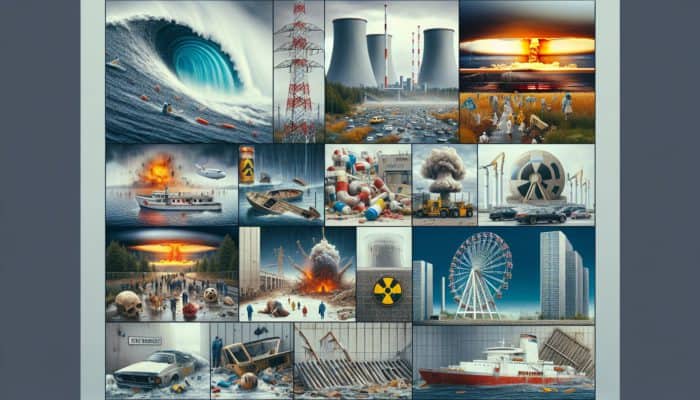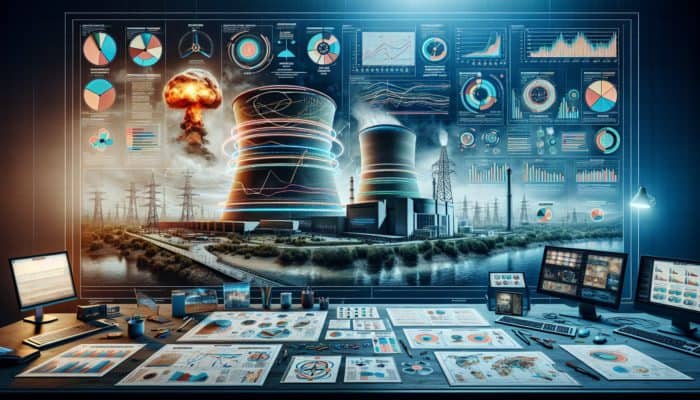Comprehensive Insights into Nuclear Event Risks
Diverse Categories of Nuclear Incidents

Preparing for Nuclear Events: Nuclear events can arise from various sources, including accidents, deliberate attacks, or natural disasters affecting nuclear facilities. Each category poses distinct challenges that necessitate tailored preparedness strategies. Accidental incidents, such as meltdowns or leaks, often occur due to human error or technical malfunctions. A stark illustration of this is the Fukushima disaster in Japan, where a devastating tsunami incapacitated the reactor cooling systems, culminating in catastrophic failures. On the other hand, intentional attacks, particularly those involving nuclear materials, have raised alarm globally, especially in politically volatile areas. Lastly, natural disasters can severely impact nuclear power plants, necessitating robust infrastructure that can withstand seismic events or flooding. The Chernobyl disaster is a prime example of how subpar design and governance exacerbated the crisis.
Grasping these distinctions is crucial for devising effective preparedness strategies. Each incident type demands a unique response approach, underscoring the necessity for a comprehensive preparedness plan that can save lives and alleviate risks. Ensuring that communities are well-informed and equipped to handle various nuclear scenarios is essential for enhancing overall safety and resilience.
Evaluating the Probability and Impact of Nuclear Events
Evaluating the likelihood and potential impacts of nuclear events is fundamental for effective planning and resource allocation. This evaluation process involves scrutinising historical data and current trends to pinpoint vulnerable areas and possible scenarios. For instance, regions with aging nuclear facilities, such as parts of Eastern Europe, may face heightened risks due to outdated technology and infrastructure. By employing predictive modelling, authorities can simulate possible incidents and their repercussions, which aids in crafting effective response strategies.
Furthermore, understanding the probable impacts, including radiation exposure and community displacement, is vital for prioritising resources and training initiatives. By assessing these probabilities, stakeholders can develop customised response plans that significantly bolster community resilience against impending nuclear incidents. This proactive stance not only enhances safety but also fosters confidence among residents regarding their preparedness for such events.
What Factors Heighten Nuclear Risks?
Numerous factors contribute to increased nuclear risks. A significant concern is the aging infrastructure, particularly in facilities constructed decades ago that may not meet contemporary safety standards. The political instability of a region can amplify these risks, especially when nuclear materials are involved. In nations where governance is fragile, the threat of theft or misuse of nuclear resources is considerably elevated. Moreover, technological failures, such as software errors or equipment malfunctions, can lead to catastrophic incidents if not addressed promptly and effectively.
Identifying these risk factors is crucial for developing effective mitigation strategies. Regular inspections, technology upgrades, and robust regulatory frameworks are essential steps that can be implemented on a global scale to diminish vulnerabilities in nuclear facilities, thereby enhancing safety and preparedness. By taking a proactive approach, communities can significantly reduce their exposure to nuclear risks.
Strategies for Mitigating Nuclear Event Risks

Implementing effective strategies to mitigate nuclear event risks is imperative for protecting communities. Key strategies include adhering to rigorous safety protocols, which encompass routine inspections and maintenance of nuclear facilities to ensure that any emerging issues are promptly addressed. International cooperation is also crucial in bolstering nuclear safety, as sharing best practices and technological advancements can significantly enhance preparedness and response capabilities. Countries can collaborate on emergency response drills, ensuring that all stakeholders are well-prepared for potential nuclear incidents.
Additionally, fostering a culture of safety within organisations that manage nuclear facilities promotes vigilance and accountability. Training personnel to identify and respond to potential threats efficiently can reduce the likelihood of incidents occurring. Through a multifaceted approach that combines stringent safety measures, international collaboration, and a robust safety culture, the risks associated with nuclear events can be significantly diminished.
Expert Perspectives on Nuclear Event Preparedness
Highlighting Real-World Examples of Effective Preparedness
Real-world examples of successful nuclear event preparedness underscore the importance of readiness and highlight effective strategies for mitigating risks. A notable example is the U.S. Nuclear Regulatory Commission, which regularly conducts drills in collaboration with local emergency services to ensure preparedness for potential nuclear accidents. These comprehensive exercises simulate various scenarios, allowing participants to practice their response protocols and refine their actions based on valuable lessons learned.
Another noteworthy example is the International Atomic Energy Agency (IAEA), which assists countries in establishing robust emergency response frameworks. This includes training programmes that emphasise the significance of community involvement in preparedness efforts. Such proactive measures serve as critical case studies, illustrating the importance of preparedness in mitigating the impacts of nuclear incidents on affected populations.
Providing Actionable Steps for Immediate Responses

In the immediate aftermath of a nuclear event, swift and decisive actions are paramount for minimising harm and ensuring safety. Individuals and communities should prioritise evacuation to a safe distance from the affected area. Familiarity with local evacuation routes and having a pre-established plan can significantly reduce confusion and facilitate a prompt response. Additionally, communities must designate specific shelter-in-place zones where residents can find refuge if evacuation is not immediately feasible.
Implementing a comprehensive communication strategy is essential to ensure that accurate and timely information is disseminated throughout the community. This might involve setting up emergency alert systems and utilising local media to provide regular updates on the situation. Lastly, individuals should have access to emergency kits containing essential supplies, which should be routinely updated. These immediate response steps are critical for safeguarding lives and enhancing community resilience during nuclear emergencies.
How Can Experts Enhance Preparedness Plans?
Experts play a crucial role in enhancing the effectiveness and reliability of preparedness plans for nuclear events. Their involvement is vital in developing comprehensive strategies that address potential risks and outline clear response protocols. By conducting training sessions, experts equip communities with the necessary knowledge and skills to react efficiently during a nuclear incident. For instance, workshops on radiation safety and emergency response can instill confidence in individuals facing nuclear threats.
Moreover, experts can offer ongoing support and updates to ensure that preparedness plans remain pertinent and effective in light of emerging technologies and evolving risks. Their insights can help refine existing plans based on lessons learned from prior incidents, ensuring continuous improvement in community preparedness. Collaborating with experts fosters a proactive approach to nuclear event readiness, thereby enhancing overall safety and resilience.
Creating an Effective Nuclear Event Preparedness Plan
Essential Components of a Comprehensive Preparedness Plan
An effective preparedness plan for nuclear events should incorporate several key components to ensure a structured and efficient response. Emergency contacts, including local authorities and emergency services, should be readily accessible for quick access during crises. Clearly defined evacuation routes are also essential, empowering residents to navigate to safety without hesitation during emergencies. Including a supply list within the plan helps ensure that individuals and families are equipped with the necessary items, such as food, water, and medical supplies.
Regular reviews and practice of the preparedness plan are vital for maintaining familiarity and efficiency during an actual event. Each component of the plan should be tailored to the specific needs and resources of the community, taking into account factors such as population density and local infrastructure. By addressing these critical elements, communities can significantly enhance their preparedness for nuclear incidents, ultimately saving lives and alleviating panic during emergencies.
How Can Communities Collaborate on Effective Plans?
Collaboration among community members is essential for developing effective nuclear event preparedness plans. Organizing regular meetings allows stakeholders to share insights, resources, and experiences, fostering a sense of collective responsibility. Such gatherings can include representatives from local government, emergency services, educational institutions, and neighborhood organizations, ensuring that diverse perspectives are considered during the planning process.
Conducting joint drills enhances collaboration by enabling various stakeholders to practice their roles in a coordinated manner. These drills can simulate nuclear incidents, providing valuable hands-on experience that highlights areas for improvement. Communities can also share resources, such as emergency supplies and training materials, to ensure that all members are adequately equipped to respond to emergencies. This collaborative approach not only strengthens community bonds but also amplifies overall preparedness for potential nuclear events.
What Advantages Come from Regular Plan Updates?
Regular updates to nuclear event preparedness plans are critical for maintaining their relevance and effectiveness. As technology evolves and risks change, these plans must be adjusted to incorporate new methodologies and insights. For instance, advancements in radiation detection technology can enhance monitoring capabilities, necessitating updates to response protocols.
Additionally, lessons learned from past nuclear incidents should inform revisions to the plan. By analysing the effectiveness of responses in previous events, communities can pinpoint weaknesses and implement corrective measures. Regular updates also cultivate a culture of preparedness, encouraging individuals and organisations to stay engaged and informed about nuclear risks. Through consistent reviews and revisions, preparedness plans can be continually refined, ensuring that they remain robust and reliable in the face of evolving challenges.
Training and Education for Nuclear Event Preparedness
Fundamental Training Programmes
Implementing essential training programmes is critical for equipping individuals with the necessary skills to respond effectively during nuclear events. Training should encompass first aid, with a focus on triaging potential radiation exposure and treating injuries that may occur during an incident. Additionally, radiation safety training is vital, enabling participants to grasp the risks associated with nuclear exposure and the protective measures they can adopt to mitigate harm.
Emergency response protocols must also be a core element of training programmes. Participants should engage in simulations and drills that replicate potential nuclear scenarios, allowing them to practice their responses in a controlled environment. These training programmes enhance individual confidence and preparedness, ultimately leading to more effective community responses during actual nuclear incidents. By investing in comprehensive training, communities can bolster their overall resilience against nuclear threats.
Accessible Educational Resources for the Public
Providing educational resources to the public is fundamental for fostering widespread awareness and preparedness for nuclear events. Resources such as brochures, online courses, and community workshops can help disseminate crucial information regarding nuclear risks and preparedness measures. These educational initiatives should encompass topics such as emergency kits, evacuation plans, and communication strategies, empowering individuals to take proactive steps to protect themselves and their families.
Furthermore, leveraging social media platforms can enhance outreach efforts by allowing organisations to share timely updates and educational content. Engaging the community through interactive programmes and discussions can further reinforce the importance of preparedness. By prioritizing public education, communities can cultivate a culture of readiness that ensures individuals are well-informed and capable of responding effectively in the event of a nuclear emergency.
How Can Schools and Workplaces Implement Effective Training?
Schools and workplaces play a pivotal role in implementing training programmes that enhance nuclear event preparedness. In educational settings, integrating preparedness training into existing safety protocols guarantees that students and staff are familiar with response strategies. Regular drills can help students practice evacuation routes and become familiar with emergency procedures, reinforcing their readiness during actual incidents.
Workplaces should similarly develop training programmes that prioritise employee safety in the event of a nuclear event. Providing educational materials, conducting workshops, and hosting guest speakers can enhance overall awareness and preparedness. Collaborating with local emergency services for training sessions can further strengthen workplace readiness. By embedding preparedness training into institutional frameworks, schools and workplaces can significantly contribute to community resilience against nuclear risks.
Essential Emergency Supplies and Equipment for Nuclear Events
What Supplies Are Indispensable for Nuclear Events?
Having a well-stocked emergency kit is crucial during nuclear events, as it significantly impacts survival rates. Essential supplies should include:
- Water: At least one gallon per person per day for a minimum of three days.
- Non-perishable food: A three-day supply of items that do not necessitate cooking or refrigeration.
- Radiation detectors: Devices such as Geiger counters to monitor radiation levels.
- Protective gear: Items like masks and radiation suits to minimise exposure to harmful substances.
- First aid kit: Basic medical supplies to treat injuries.
- Flashlights and batteries: To ensure visibility during power outages.
- Whistle: For signalling for help if trapped.
- Local maps: To navigate to safety in the event of evacuation.
Ensuring these supplies are readily available can significantly enhance individual and community preparedness, guaranteeing that essential needs are met during a crisis.
Ensuring Proper Maintenance and Storage of Emergency Equipment
Proper maintenance and storage of emergency equipment are vital for ensuring its functionality during a nuclear crisis. Equipment such as radiation suits and Geiger counters should be regularly inspected for signs of wear and tear. Establishing a routine maintenance schedule can help identify any issues before they escalate into critical problems.
Storage conditions also play a significant role in equipment readiness. Items should be kept in a cool, dry place, away from direct sunlight, to prevent deterioration. Clearly labelling storage containers and maintaining an inventory of supplies can streamline access during emergencies, ensuring that community members can quickly locate the necessary equipment. By prioritising maintenance and proper storage, individuals and communities can enhance their preparedness for nuclear events.
How Can Individuals Create Their Own Emergency Kits?
Individuals can take proactive steps to prepare their own emergency kits by assembling necessary supplies tailored to their specific needs. Start by including essential items such as food, water, and medical supplies, ensuring to account for the number of people in the household. Regularly checking expiration dates and replacing items as needed is crucial to maintaining the kit’s effectiveness.
Storing kits in easily accessible locations ensures that they can be quickly retrieved during emergencies. Consider designating a specific area in the home for the emergency kit, where all family members are aware of its location. Additionally, encouraging family discussions about the contents of the kit and the importance of preparedness can foster a collective sense of readiness. Personal emergency kits are indispensable for individual preparedness, empowering families to respond effectively during nuclear incidents.
Effective Communication Strategies During Nuclear Events
Establishing Reliable Communication Channels
Establishing reliable communication channels is essential for disseminating information during nuclear events. Implementing emergency alert systems can ensure that critical updates are sent directly to residents, providing timely information about evacuation orders or safety protocols. Additionally, utilising radio broadcasts can reach a broader audience, especially in areas with limited internet access.
Communities should prioritise developing robust communication networks that involve local authorities, emergency services, and community organisations. This collaboration ensures that accurate information is shared promptly, thereby reducing the likelihood of misinformation during crises. By establishing reliable communication channels, communities can enhance their overall response efforts to nuclear events.
What Are the Best Practices for Effective Communication?
Effective communication during nuclear events hinges on several best practices. Clear and concise messaging is paramount, ensuring that vital information is easily comprehensible for all community members. Regular updates should be disseminated to keep the public informed about the evolving situation, especially as new developments arise.
Utilising multiple communication methods can broaden the reach of messages. For instance, combining text alerts, social media updates, and traditional media can help ensure that information reaches a diverse audience. Establishing a community information centre can also serve as a hub for inquiries and updates during a nuclear event, assisting in coordinating responses and alleviating public concerns. By implementing these best practices, communities can enhance their communication efforts during nuclear incidents.
How Can Social Media Be Utilised Effectively During Emergencies?
Social media can be a powerful tool for enhancing communication during nuclear events. Utilising platforms like Twitter and Facebook allows for real-time updates, enabling authorities to disseminate critical information swiftly. Engaging with the community through social media can also facilitate two-way communication, allowing residents to ask questions and receive immediate responses.
Proper usage of social media includes maintaining a consistent tone and ensuring that information shared is accurate and verified. Establishing a designated team to manage social media communications can streamline efforts and prevent the spread of misinformation. By leveraging the capabilities of social media, communities can enhance their communication strategies and coordinate responses effectively during nuclear emergencies.
Proven Strategies for Preparing for Nuclear Events
Offering Expert Analysis on Evacuation Plans
Expert analysis on evacuation plans is crucial for ensuring their robustness and effectiveness. Evacuation plans should clearly define routes that account for the fastest and safest paths away from affected areas. Experts can provide insights on optimal timing for evacuations, as traffic congestion can significantly impede response efforts.
Coordination with emergency services is equally vital, as authorities can provide real-time information about hazards and road conditions. Regularly reviewing and updating evacuation plans based on expert recommendations ensures that communities remain prepared and responsive to potential nuclear incidents. By engaging experts, communities can enhance their evacuation strategies, ultimately safeguarding lives during emergencies.
Implementing Effective Shelter-in-Place Protocols
Implementing shelter-in-place protocols is crucial for immediate safety during nuclear events. These protocols involve remaining indoors, sealing rooms, and employing protective measures to minimise radiation exposure. Communities should establish clear guidelines on how to effectively shelter in place, including identifying safe zones within buildings and ensuring access to necessary supplies.
Residents should be educated on the importance of sealing windows and doors to prevent contaminated air from entering. Using air filtration systems or improvised methods, such as damp towels, can further enhance protection. By implementing and practising shelter-in-place protocols, communities can significantly reduce exposure risks during nuclear incidents, thereby enhancing overall safety and preparedness.
What Are the Most Effective Decontamination Methods?
Effective decontamination methods are essential for ensuring safety following nuclear events. The primary methods include using soap and water to wash off radioactive particles from exposed skin and clothing. This straightforward yet effective approach can significantly diminish contamination levels.
Specialised cleaning agents may also be employed for surfaces and equipment to guarantee thorough decontamination. Following expert guidelines is critical, as they can provide specific recommendations tailored to the incident and contamination levels. Community training on decontamination procedures can further enhance individual preparedness, ensuring residents are equipped to handle potential contamination effectively. By implementing these methods, communities can enhance safety during and after nuclear events.
Educating the Public on Nuclear Event Preparedness
Educating the public on nuclear event preparedness entails disseminating comprehensive information regarding safety measures, emergency kits, and communication strategies. Community workshops and informational sessions can serve as platforms for sharing knowledge and addressing public concerns about nuclear risks.
Utilising various channels, including social media, local newsletters, and community bulletins, can enhance outreach efforts. Providing accessible materials that outline preparedness steps and resources can empower individuals to take proactive measures to safeguard themselves and their families. Engaging the public in discussions about nuclear safety fosters a culture of resilience and readiness, ultimately enhancing overall community preparedness for nuclear incidents.
Psychological Preparedness for Nuclear Events
Coping Mechanisms for Managing Stress and Anxiety
Coping mechanisms for managing stress and anxiety during nuclear events are essential for maintaining community resilience. Techniques such as mindfulness and deep breathing exercises can help individuals remain grounded in high-stress situations. Furthermore, establishing support groups enables individuals to share their experiences and coping strategies, thereby fostering a sense of community and collective support.
Professional counselling may also prove beneficial, providing individuals with access to trained therapists who can offer tools to navigate their emotional responses during crises. Communities can organise workshops focused on mental health awareness, helping residents recognise and address their psychological needs during nuclear events. By emphasising mental health preparedness, individuals can enhance their ability to cope with the psychological impacts of nuclear incidents.
How Can Communities Proactively Support Mental Health?
Communities can play a pivotal role in supporting mental health during nuclear events by providing vital resources and establishing support networks. Organising community events that promote mental health awareness can encourage open discussions about stress and anxiety associated with nuclear risks.
Offering access to trained mental health professionals for counselling services can further bolster community support systems. Establishing crisis hotlines can also provide immediate assistance for individuals in distress, ensuring they have a dependable avenue for help. By actively promoting mental health resources, communities can enhance psychological resilience and assist individuals in navigating the challenges associated with nuclear events.
What Role Does Education Play in Psychological Preparedness?
Education plays a crucial role in psychological preparedness for nuclear events by informing individuals about the risks, available preparedness measures, and effective coping strategies. Providing educational materials focused on mental health can empower individuals to understand their emotions and responses during crises. Workshops and seminars can facilitate discussions about the psychological aspects of nuclear preparedness, equipping community members with tools to manage anxiety.
Promoting educational initiatives in schools and workplaces can raise awareness about mental health issues and encourage proactive approaches to psychological preparedness. By fostering a culture of education surrounding mental health, communities can enhance overall resilience and preparedness during nuclear incidents.
How Can Families Prepare Psychologically for Nuclear Events?
Families can prepare psychologically for nuclear events by engaging in open discussions about nuclear risks and collaboratively establishing emergency plans. Creating a comprehensive family plan that outlines actions to take during a nuclear incident can instill confidence in each family member’s ability to respond effectively and efficiently.
Practising coping strategies together, such as mindfulness techniques or deep breathing exercises, can enhance collective resilience. Encouraging family members to express their feelings and concerns about nuclear risks fosters a supportive environment where everyone can address their emotional needs. By prioritising psychological preparedness within the family unit, individuals can strengthen their overall readiness for potential nuclear events.
The Importance of Mental Health First Aid During Nuclear Crises
Mental health first aid training is vital for equipping individuals to provide initial support to those experiencing psychological distress during nuclear crises. This training educates participants to recognise signs of mental health struggles and respond appropriately, offering reassurance and guidance to affected individuals.
By establishing community members as mental health first responders, communities can harness their collective strengths to support those in need. Providing resources and training on mental health first aid can enhance overall community resilience, ensuring that individuals have access to timely assistance during nuclear events. By prioritising mental health support, communities can mitigate psychological distress and promote healing after crises.
Long-Term Recovery and Rehabilitation Following Nuclear Events
Strategies for Sustainable Long-Term Recovery
Long-term recovery strategies following nuclear events are essential for rebuilding communities and restoring normalcy. These strategies may encompass rebuilding infrastructure, reinstating essential services, and offering ongoing support to affected populations. Establishing clear timelines and objectives for recovery can help communities maintain their focus on achieving these goals.
Moreover, engaging community members in the recovery process fosters a sense of ownership and empowerment. Collaborative efforts involving local leaders, government agencies, and non-profit organisations can enhance the effectiveness of recovery initiatives. By prioritising long-term recovery strategies, communities can rebuild resilience and ensure adequate support for those affected by nuclear events.
What Are the Key Challenges in Rehabilitation Efforts?
Key challenges in rehabilitation after nuclear events include managing radiation contamination, addressing health concerns, and rebuilding community trust—contaminated land and infrastructure present significant obstacles, necessitating specialised cleanup efforts and ongoing monitoring to ensure safety.
Health concerns may arise due to potential radiation exposure, requiring comprehensive medical assessments and support for affected individuals. Rebuilding community trust is equally critical, as previous incidents may engender scepticism regarding safety measures and government responses. Addressing these challenges through transparency, community engagement, and ongoing support is vital for successful rehabilitation following nuclear events.
How Can Communities Foster Resilience for Future Nuclear Events?
Building resilience for future nuclear events involves learning from past experiences and implementing enhanced preparedness measures. Communities should prioritise the development of robust emergency response plans that reflect lessons learned from previous incidents.
Fostering a culture of readiness through continuous training, education, and community engagement ensures that residents remain informed about risks and preparedness strategies. By investing in infrastructure improvements and conducting regular drills, communities can bolster their overall resilience to nuclear events. Through collective efforts and a steadfast commitment to preparedness, communities can secure better outcomes during future nuclear incidents.
Frequently Asked Questions
What are the primary types of nuclear incidents?
Nuclear incidents can be categorised as accidental, intentional (e.g., terrorism), or natural disasters impacting nuclear facilities. Each type demands different preparedness strategies.
How can I assess the likelihood of a nuclear event occurring?
Assessing the likelihood involves analyzing historical data, current trends, and factors such as aging infrastructure and political stability to identify potential risks.
What can increase the risks associated with nuclear events?
Factors such as aging infrastructure, political instability, and technological failures can heighten the risks related to nuclear events.
What strategies can help mitigate nuclear risks?
Implementing safety protocols, conducting regular maintenance, and fostering international cooperation are effective strategies for reducing nuclear risks.
Could you provide examples of successful preparedness initiatives?
Examples of successful preparedness include regular drills conducted by the U.S. Nuclear Regulatory Commission and support from the IAEA to enhance community readiness.
What immediate actions should I take following a nuclear event?
Immediate actions encompass evacuating to a safe location, sheltering in place if necessary, and accessing reliable information through emergency communication channels.
How do experts contribute to the development of preparedness plans?
Experts contribute by formulating comprehensive plans, conducting training sessions, and providing ongoing support to enhance community readiness and resilience.
What key components should be included in a preparedness plan?
Key components encompass emergency contacts, evacuation routes, and supply lists to ensure a structured and efficient response to nuclear events.
How can schools implement training for nuclear preparedness?
Schools can integrate preparedness training into existing safety protocols, conduct regular drills, and provide educational materials to students and staff.
Why is mental health support vital during nuclear events?
Mental health support is essential for managing stress and anxiety, aiding individuals in coping with the psychological impacts of nuclear events, and fostering community resilience.
Explore more with us on X!
Post-Disaster Bartering: Essential Strategies
Exploring the Concept of Post-Disaster Bartering What Is the Concept of Post-Disaster Bartering? Post-Disaster Bartering: Post-disaster bartering refers to the exchange of goods and services that occurs when conventional currency systems collapse due to catastrophic events, such as natural disasters, economic crises, or societal upheavals. During these critical moments, individuals and communities utilise the resources […]
Hurricane Generator Use: Powering Through Storms
Maximising the Benefits of Hurricane Generator Usage What Exactly Are Hurricane Generators? Hurricane Generator Use: Hurricane generators are advanced power supply devices specifically engineered to deliver electricity during extreme weather events, particularly during hurricanes, when standard power infrastructures may fail. These robust machines ensure that both residential and commercial establishments receive the power they need, […]
Emergency Family Plan: Universal Preparation Guide
Comprehensive Elements to Include in Your Family Emergency Plan Effective Communication Strategies for Emergencies Emergency Family Plan: Establishing effective communication strategies is absolutely vital for ensuring that family members remain connected and informed during emergencies. It’s crucial to have clear, reliable methods in place that everyone understands and can utilise effortlessly. This encompasses traditional communication […]
Survival Water Bottles: Essential Gear for Emergencies
Why Survival Water Bottles are Essential for Emergency Preparedness Understanding the Significance of Hydration in Crisis Situations Survival Water Bottles: Maintaining hydration is vital for ensuring optimal bodily functions during emergencies. In scenarios where access to clean water is limited, sustaining proper hydration is crucial in preventing health complications associated with dehydration, which can include […]








It’s fascinating to dive into the nuances of nuclear event risks and their varying categories. When I read about events like Fukushima and Chernobyl, I can’t help but think about how our society has responded to these disasters. They were not just technical failures but also profound societal moments that reshaped public perceptions of nuclear energy.